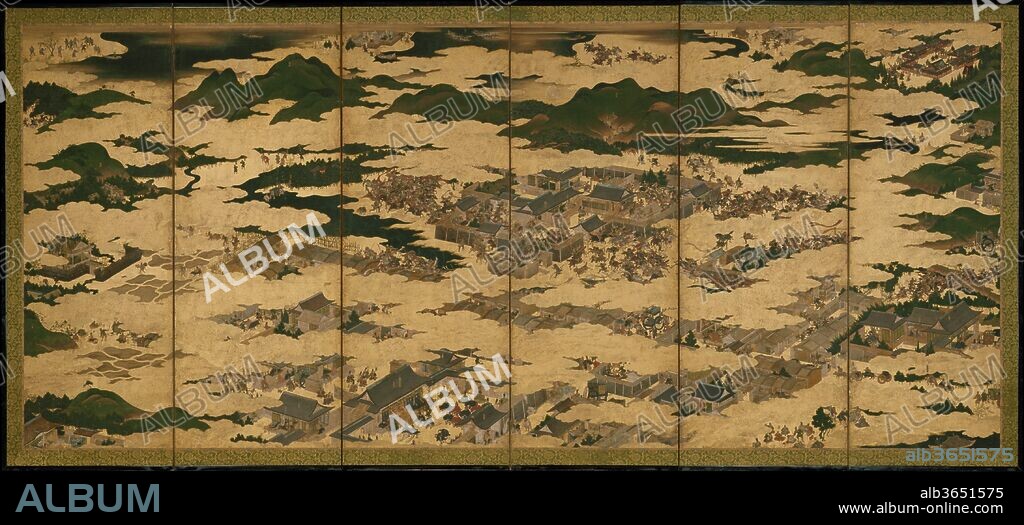alb3651575
The Rebellions of the Hogen and Heiji Eras

|
Ajouter à une autre Lightbox |
|
Ajouter à une autre Lightbox |



Avez-vous déjà un compte? S'identifier
Vous n'avez pas de compte ? S'inscrire
Acheter cette image

Titre:
The Rebellions of the Hogen and Heiji Eras
Légende:
Voir la traduction automatique
The Rebellions of the Hogen and Heiji Eras. Culture: Japan. Dimensions: Image (each screen): 60 15/16 x 140 in. (154.8 x 355.6 cm). Date: 17th century.
The Hogen Rebellion, which occurred in central Kyoto in the summer of 1156, involved a dispute over succession between Emperor Go-Shirakawa and former Emperor Sutoku. Although it lasted only a few hours, this skirmish, along with the later Heiji Rebellion, had far-reaching political and social consequences and marked the beginning of the medieval period, characterized by the rise of a warrior class. Progressing from right to left, the screen illustrates a number of legendary fighting scenes as narrated in The Tale of the Hogen Rebellion.
Scene One: Alliance Formed by Sutoku, Fujiwara no Yorinaga, and Minamoto no Tameyoshi (Fourth panel from left, bottom and center)
Feeling neglected, Emperor Sutoku allies with the ambitious Minister of the Left, Fujiwara no Yorinaga, and the warrior Minamoto no Tameyoshi to strengthen his position. At the side of the elderly Tameyoshi is his son Tametomo, known for his imposing physique and legendary talent in archery.
Scene Two: Night Attack on Sutoku's Palace (Center)
In the middle of the night on July 9, Emperor Go-Shirakawa's men attack Emperor Sutoku's Shirakawa Palace, which is the climax of The Tale of Hogen Rebellion. The Minamoto and other warrior clans are divided, even within families, so that fathers are pitted against sons and brothers against brothers. The fight rages for four hours, leaving the palace compound in total chaos and fire.
Scene Three: The Escape of Fujiwara no Yorinaga (Sixth panel from left, bottom)
Yorinaga barely survives an arrow wound received during his escape from the palace. Hiding under a pile of brushwood on a boat, he is ferried to his father in Uji, who refuses to take Yorinaga into his care. Disillusioned, Yorinaga commits suicide by cutting off his tongue.
Scene Four: Sutoku's Exile to a Distant Island (Sixth panel from left, top)
Emperor Sutoku is exiled to a barren island in Sanuki, southwest of Kyoto. Isolated and confined to a small hut, he desperately seeks salvation by copying Buddhist sutras. Yet, when the court rejects his plea to dedicate the sutras to a temple near the city, he is no longer able to maintain his sanity and dies of madness.
Scene Five: The Final Demise of Minamoto no Tametomo (Third panel from left, top)
After being captured by Emperor Go-Shirakawa's army, Tametomo, famed for his archery skills, suffers a permanent injury to his arm and is banished to the remote island of Izu Oshima, east of the capital of Kyoto. Some fourteen years after the Hogen Rebellion, the imperial troops invade the island. Tametomo reveals his regained archery skills by sinking one of the ships with a single arrow, but, aware of his utter lack of armed support, he commits ritual suicide.
Technique/matériel:
Pair of six-panel folding screens; ink, color, gold and gold leaf on paper
Période:
Edo period (1615-1868)
Musée:
Metropolitan Museum of Art, New York, USA
Crédit:
Album / Metropolitan Museum of Art, NY
Autorisations:
Modèle: Non - Propriété: Non
Questions sur les droits?
Questions sur les droits?
Taille de l'image:
4573 x 2107 px | 27.6 MB
Taille d'impression:
38.7 x 17.8 cm | 15.2 x 7.0 in (300 dpi)
Mots clés:
 Pinterest
Pinterest Twitter
Twitter Facebook
Facebook Copier le lien
Copier le lien Email
Email
